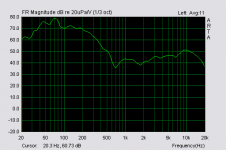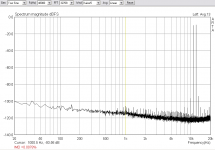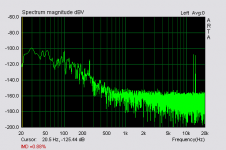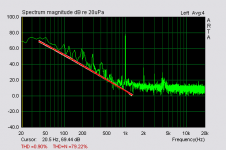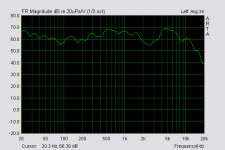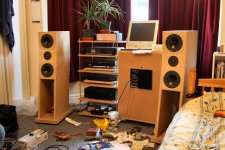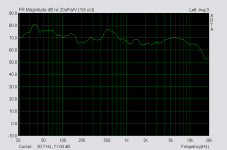I don't know why it didn't occur me to mention it before, but another reason to get that soundcard would have been because it sports phantom power for mics and very good spec preamps. Although I'm not sure if and how one might configure it since you'd still want to use the line in and outs.#
Hmm, anyway, here's the specs if you're interested: http://www.emu.com/products/product.asp?category=610&subcategory=611&product=15185
Hmm, anyway, here's the specs if you're interested: http://www.emu.com/products/product.asp?category=610&subcategory=611&product=15185
That looks really nice that, impressive blurb and lots of knobs and sockets 😀. But I couldn't spend that kind of money at the moment anyway. The mic and phantom power etc. only came to £61 total.
Re: SimonY
http://www.diyaudio.com/forums/showthread.php?postid=1164136#post1164136ttan98 said:What is the total price of My ECM8000, phantom power box ?
Here's my first effort of measuring an acoustic frequency response. Something doesn't seem to be right: I'm sure the bass isn't 40dB louder than the mid-range right next to the speaker...
At least the mic seems to be picking something up, even if I've got a setting wrong somewhere.
Probably time to call it a day now!
Simon
At least the mic seems to be picking something up, even if I've got a setting wrong somewhere.
Probably time to call it a day now!
Simon
Attachments
One problem I initially ran into while measuring the loop-back response of my sound card was the high frequency response- it was rolled off sharply at just over 5 khz. It turns out that there was nothing wrong with the output- the input was the problem. There was a software profile running for the sound chip that had the microphone set to "speech recording" mode, where all of the highs and some of the lows were cut off in software.
Double check that all the settings, and your whole input/output chain. Other than that, it's very nice to see any sort of curve at all, isn't it? 🙂
Double check that all the settings, and your whole input/output chain. Other than that, it's very nice to see any sort of curve at all, isn't it? 🙂
Hi Joe,
Well yes it's very nice to see a curve, even if it's wildy distorted.
The soundcard is not, I don't think, the problem here. The soundcard looked just fine in loop mode and I performed various test, including IMD at 11khz and 12khz - see attachment.
I'm now worried the apparent response error could be in the mic. preamp. I can't see why else it could be so off. I might be able to use a DJ mixer for the mic preamp and try that. Not sure what the next step is to resolve this.
It's late here now, so I'm off to bed! I will be dreaming of ARTA and pink noise pulses
Simon
Well yes it's very nice to see a curve, even if it's wildy distorted.
The soundcard is not, I don't think, the problem here. The soundcard looked just fine in loop mode and I performed various test, including IMD at 11khz and 12khz - see attachment.
I'm now worried the apparent response error could be in the mic. preamp. I can't see why else it could be so off. I might be able to use a DJ mixer for the mic preamp and try that. Not sure what the next step is to resolve this.
It's late here now, so I'm off to bed! I will be dreaming of ARTA and pink noise pulses

Simon
Attachments
Hmm, it's clear that the mic is picking something up, but it seems to be "buried" in noise or something! In this IMD test of 13khz and 14khz you can clearly see the peaks in the correct places, but just look at the huge amount of noise in the lower end of the graph! What on earth is happening here?? 

Attachments
I've been playing around with my setup some more and something is clearly wrong here! There appears to be noise rising at about 6dB/octave (see red line on attached plot: 6dB/octave slope for comparison).
Anyone have any ideas why I'd get this noise? The following plot is a fairly loud (overloaded perhaps) 1khz sinewave test.
Please help me, I really want to get some good measurements made soon!!
Simon
Anyone have any ideas why I'd get this noise? The following plot is a fairly loud (overloaded perhaps) 1khz sinewave test.
Please help me, I really want to get some good measurements made soon!!
Simon
Attachments
Good job tracking it down to that and putting in the lines- it definitely looks like some phenomena that we can isolate.
Can we get some more description of the measurement setup?
Amplifier?
Mic position?
Speaker position in room?
Room size?
Ambient acoustic noise?
If the trend started at a lower frequency, I'd suggest it was room gain. As it is, your room would have to be the size of a speaker cabinet to explain this (although it would explain it rather well). The next thing I'd look for is the amplifier- if it's a receiver, is it possible that it might actually have a bass boost of some sort?
I would ask how sure you are that your speakers are relatively flat, but 40 db bass boost doesn't seem like you could possibly not notice.
Finally, the measurement settings in software could have something to do with it. Maybe one of the gurus knows something- I don't, I'm on the same learning curve as you right now. I'll play around a little bit with a loopback and see if I can recreate something like what you have.
Oh- something reminded me of feedback... there's no chance that the microphone input is being played out of the speaker, is there? That'd probably just squeal, but with test tones I can't be sure of the behavior.
edit- I just checked, couldn't find anything in ARTA to explain it.
Can we get some more description of the measurement setup?
Amplifier?
Mic position?
Speaker position in room?
Room size?
Ambient acoustic noise?
If the trend started at a lower frequency, I'd suggest it was room gain. As it is, your room would have to be the size of a speaker cabinet to explain this (although it would explain it rather well). The next thing I'd look for is the amplifier- if it's a receiver, is it possible that it might actually have a bass boost of some sort?
I would ask how sure you are that your speakers are relatively flat, but 40 db bass boost doesn't seem like you could possibly not notice.
Finally, the measurement settings in software could have something to do with it. Maybe one of the gurus knows something- I don't, I'm on the same learning curve as you right now. I'll play around a little bit with a loopback and see if I can recreate something like what you have.
Oh- something reminded me of feedback... there's no chance that the microphone input is being played out of the speaker, is there? That'd probably just squeal, but with test tones I can't be sure of the behavior.
edit- I just checked, couldn't find anything in ARTA to explain it.
Thanks for replying Joe.
The amp is my hi-fi amp (no boosts or anything other than a small baffle step correction circuit - 3dB more or less).
The mic gives this kind of respone anomaly anywhere in the room, and even out of the room.
Speakers are where they sound best, what more can I say?? It sounds good. The system does NOT have 40dB of bass boost.
The room must be about 3 x 4 x 3m or so.
For comparison here is a pulsed white noise plot taken from my listening position using my cheapo microphone (using the same preamp but NOT phantom power). 1/3 octave smoothing.
Simon
The amp is my hi-fi amp (no boosts or anything other than a small baffle step correction circuit - 3dB more or less).
The mic gives this kind of respone anomaly anywhere in the room, and even out of the room.
Speakers are where they sound best, what more can I say?? It sounds good. The system does NOT have 40dB of bass boost.
The room must be about 3 x 4 x 3m or so.
For comparison here is a pulsed white noise plot taken from my listening position using my cheapo microphone (using the same preamp but NOT phantom power). 1/3 octave smoothing.
Simon
Attachments
One other thing... I played an mp3 on my computer, quietly, and monitored the signal with the spectrum analyser graph in Wavelab - there was a distinct lack of high frequencies. I recorded the sound and only bass came through!
I just stuck DVM probes into the XLR lead connected to the mic from the PS400 box to confirm the existence of 48vdc.
It's looking strongly like the ECM8000 is faulty 🙁
I just stuck DVM probes into the XLR lead connected to the mic from the PS400 box to confirm the existence of 48vdc.
It's looking strongly like the ECM8000 is faulty 🙁
Are you sure it's a purpose made mic amp and not a universal one with an RIAA mode, that is inadvertently selected?
richie00boy said:Are you sure it's a purpose made mic amp and not a universal one with an RIAA mode, that is inadvertently selected?
I may be stupid, but....
No, it's a mic preamp! And did you not see the graph I posted using a "budget" dynamic mic? This doesn't seem to suffer the same problem.
Simon
Well I think my ECM8000 is faulty, so unless anyone can suggest an alternative line of action, I'm sending it back on Monday.
Keen to do some measurements I dug out the response chart for my Prosound dynamic microphone. It's pretty poor so I made a correction file as per the ARTA manual, to bring up the bass and rolled off top end.
The result below is a 1/3 octave smoothed pulsed pink noise test taken from the listening position. It seems realistic: a bit more at the bottom than the top, which is probably how my room/system sounds. I just wish the ECM8000 was taking some measurements!
Keen to do some measurements I dug out the response chart for my Prosound dynamic microphone. It's pretty poor so I made a correction file as per the ARTA manual, to bring up the bass and rolled off top end.
The result below is a 1/3 octave smoothed pulsed pink noise test taken from the listening position. It seems realistic: a bit more at the bottom than the top, which is probably how my room/system sounds. I just wish the ECM8000 was taking some measurements!
Attachments
Hi Simon,
I'm not so sure it's your mic. I assume you're following the farfield measurment procedure: mic at > 0.5m, < 2m, taking an impulse response, setting the gating period approrpriately then viewing the FR.
Try doing nearfield measurements and see what you get:
Keep the mic <5mm from the bass driver cone. Using a low sample rate and take the impulse response and then view the FR.
If you like I can send you my mic and preamp to compare (as long as you send it back asap).
V
I'm not so sure it's your mic. I assume you're following the farfield measurment procedure: mic at > 0.5m, < 2m, taking an impulse response, setting the gating period approrpriately then viewing the FR.
Try doing nearfield measurements and see what you get:
Keep the mic <5mm from the bass driver cone. Using a low sample rate and take the impulse response and then view the FR.
If you like I can send you my mic and preamp to compare (as long as you send it back asap).
V
Vikash said:Hi Simon,
I'm not so sure it's your mic. I assume you're following the farfield measurment procedure: mic at > 0.5m, < 2m, taking an impulse response, setting the gating period approrpriately then viewing the FR.
Try doing nearfield measurements and see what you get:
Keep the mic <5mm from the bass driver cone. Using a low sample rate and take the impulse response and then view the FR.
If you like I can send you my mic and preamp to compare (as long as you send it back asap).
V
Hey Vikash,
I've not followed any specific procedure, I merely have experimented, and ultimately began trying to measure my listening position's fr. response.
I cannot take an impulse response using this setup: that requires extra connections, which I've not attempted to make yet.
Whatever I do with that ECM the results look terribly wrong.
Finally, when I recorded music through it ALL the treble and midrange information was lost. Not a "bit dull" but "completely useless". By comparison the Prosound mic sounds tinny but as expected, showing some energy across the board. The ECM looks as though everything's going through a low-pass filter!
Thank you for your kind offer to lend equipment. I do not think we need to go that far, as I am convinced my mic is faulty. I will send it back and demand a replacement.
Simon
Can you remove the maplin preamp and go
ECM8000 -> PS400 -> line in?
Svein said the PS400 is phantom power only and not a preamp.... however if Svein says all he uses is the panasonic capsule and 9V battery simple power supply (phantom?) - isn't that the same as above? (ECM8000 -> PS400 -> line in)
it could be your maplin preamp screwing things up.
If the above works - please let me know... as Iwould like to order too.
Cheers,
David.
ECM8000 -> PS400 -> line in?
Svein said the PS400 is phantom power only and not a preamp.... however if Svein says all he uses is the panasonic capsule and 9V battery simple power supply (phantom?) - isn't that the same as above? (ECM8000 -> PS400 -> line in)
it could be your maplin preamp screwing things up.
If the above works - please let me know... as Iwould like to order too.
Cheers,
David.
- Status
- Not open for further replies.
- Home
- Loudspeakers
- Multi-Way
- Help choosing measurement and modelling setup
